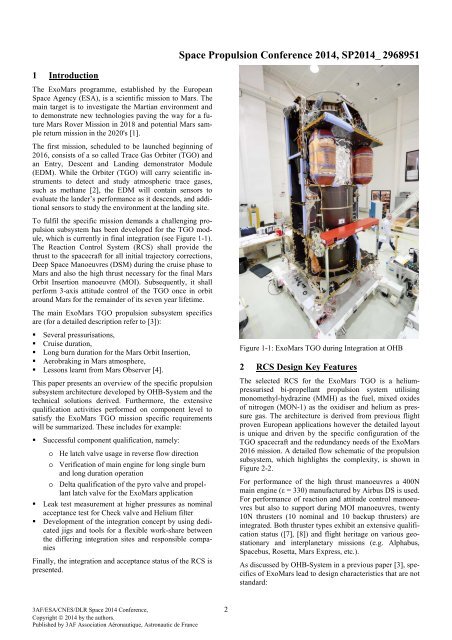1uWFeBO
1uWFeBO
1uWFeBO
You also want an ePaper? Increase the reach of your titles
YUMPU automatically turns print PDFs into web optimized ePapers that Google loves.
Space Propulsion Conference 2014, SP2014_ 2968951<br />
1 Introduction<br />
The ExoMars programme, established by the European<br />
Space Agency (ESA), is a scientific mission to Mars. The<br />
main target is to investigate the Martian environment and<br />
to demonstrate new technologies paving the way for a future<br />
Mars Rover Mission in 2018 and potential Mars sample<br />
return mission in the 2020's [1].<br />
The first mission, scheduled to be launched beginning of<br />
2016, consists of a so called Trace Gas Orbiter (TGO) and<br />
an Entry, Descent and Landing demonstrator Module<br />
(EDM). While the Orbiter (TGO) will carry scientific instruments<br />
to detect and study atmospheric trace gases,<br />
such as methane [2], the EDM will contain sensors to<br />
evaluate the lander’s performance as it descends, and additional<br />
sensors to study the environment at the landing site.<br />
To fulfil the specific mission demands a challenging propulsion<br />
subsystem has been developed for the TGO module,<br />
which is currently in final integration (see Figure 1-1).<br />
The Reaction Control System (RCS) shall provide the<br />
thrust to the spacecraft for all initial trajectory corrections,<br />
Deep Space Manoeuvres (DSM) during the cruise phase to<br />
Mars and also the high thrust necessary for the final Mars<br />
Orbit Insertion manoeuvre (MOI). Subsequently, it shall<br />
perform 3-axis attitude control of the TGO once in orbit<br />
around Mars for the remainder of its seven year lifetime.<br />
The main ExoMars TGO propulsion subsystem specifics<br />
are (for a detailed description refer to [3]):<br />
• Several pressurisations,<br />
• Cruise duration,<br />
• Long burn duration for the Mars Orbit Insertion,<br />
• Aerobraking in Mars atmosphere,<br />
• Lessons learnt from Mars Observer [4].<br />
This paper presents an overview of the specific propulsion<br />
subsystem architecture developed by OHB-System and the<br />
technical solutions derived. Furthermore, the extensive<br />
qualification activities performed on component level to<br />
satisfy the ExoMars TGO mission specific requirements<br />
will be summarized. These includes for example:<br />
• Successful component qualification, namely:<br />
o He latch valve usage in reverse flow direction<br />
o Verification of main engine for long single burn<br />
and long duration operation<br />
o Delta qualification of the pyro valve and propellant<br />
latch valve for the ExoMars application<br />
• Leak test measurement at higher pressures as nominal<br />
acceptance test for Check valve and Helium filter<br />
• Development of the integration concept by using dedicated<br />
jigs and tools for a flexible work-share between<br />
the differing integration sites and responsible companies<br />
Finally, the integration and acceptance status of the RCS is<br />
presented.<br />
Figure 1-1: ExoMars TGO during Integration at OHB<br />
2 RCS Design Key Features<br />
The selected RCS for the ExoMars TGO is a heliumpressurised<br />
bi-propellant propulsion system utilising<br />
monomethyl-hydrazine (MMH) as the fuel, mixed oxides<br />
of nitrogen (MON-1) as the oxidiser and helium as pressure<br />
gas. The architecture is derived from previous flight<br />
proven European applications however the detailed layout<br />
is unique and driven by the specific configuration of the<br />
TGO spacecraft and the redundancy needs of the ExoMars<br />
2016 mission. A detailed flow schematic of the propulsion<br />
subsystem, which highlights the complexity, is shown in<br />
Figure 2-2.<br />
For performance of the high thrust manoeuvres a 400N<br />
main engine (ε = 330) manufactured by Airbus DS is used.<br />
For performance of reaction and attitude control manoeuvres<br />
but also to support during MOI manoeuvres, twenty<br />
10N thrusters (10 nominal and 10 backup thrusters) are<br />
integrated. Both thruster types exhibit an extensive qualification<br />
status ([7], [8]) and flight heritage on various geostationary<br />
and interplanetary missions (e.g. Alphabus,<br />
Spacebus, Rosetta, Mars Express, etc.).<br />
As discussed by OHB-System in a previous paper [3], specifics<br />
of ExoMars lead to design characteristics that are not<br />
standard:<br />
3AF/ESA/CNES/DLR Space 2014 Conference, 2<br />
Copyright © 2014 by the authors.<br />
Published by 3AF Association Aéronautique, Astronautic de France


